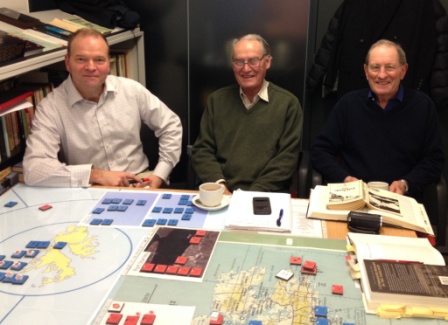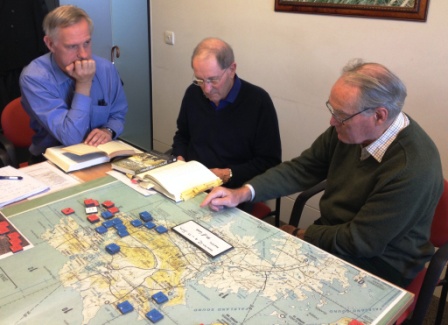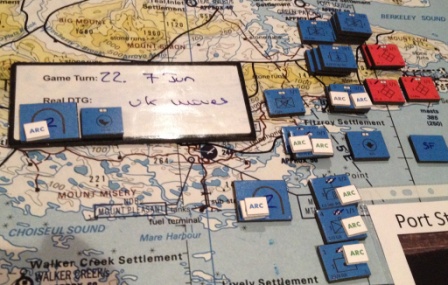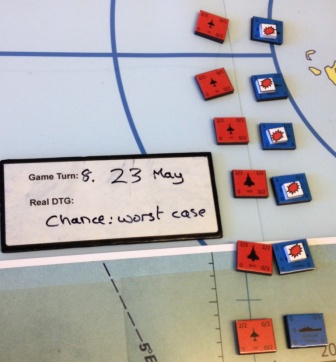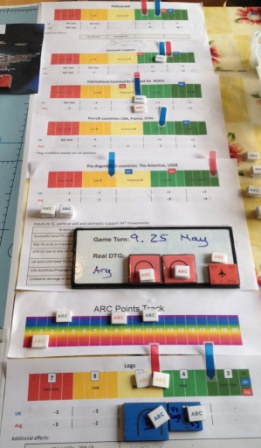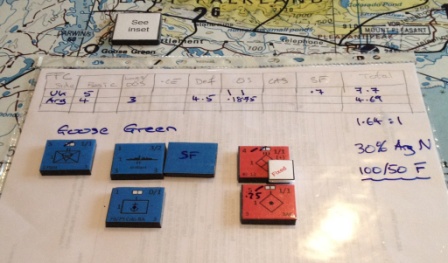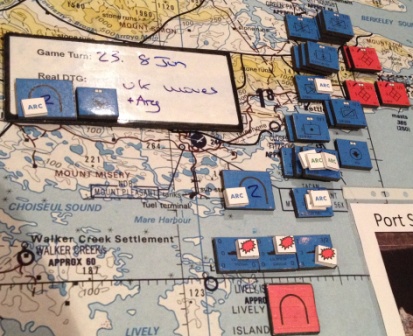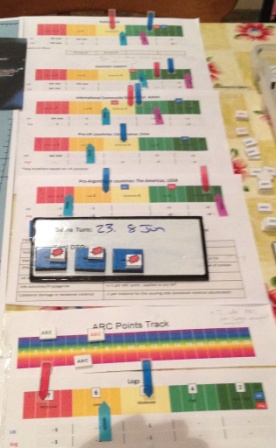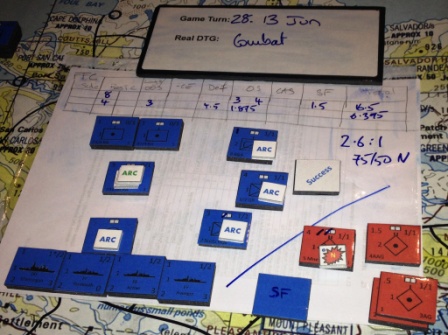Blog
RCAT Falklands War Operational Commanders’ Test ← Back to Blog index
Introduction
As part of the ongoing RCAT V&V process an Operational Commanders’ Test (OCT) was held on 13-14 Jan 15. The aim was ‘to compare an RCAT simulation of the 1982 Falklands War to the historical outcomes and command experience, identify variances and examine the reasons for these in order to improve the validity of the RCAT system.’ The operational commanders present were Gen Julian Thompson and Cdre Michael Clapp, respectively Comd 3 Cdo Bde and Comd Amphibious Task Group during the Falklands War. As such, they had perhaps the most immediate and detailed view of events at the level simulated at the OCT and were ideally placed to validate RCAT in accordance with the aim.
.
.
RCAT is a manual simulation sponsored by Dstl and developed by Cranfield University and a team of some of the best UK wargamers. This includes Jeremy Smith (Cranfield), Prof Phil Sabin (KCL), Dr Arrigo Velicogna (KCL), Colin Marston (Dstl), Charles Vasey (one of, if not the, most experienced UK wargame designers), Tom Mouat (Defence Academy), John Curry (History of Wargaming Project) and other SMEs as required. NSC provides expertise on the V&V process itself. The OCT is one of a series of tests comparing RCAT outcomes to a known historical reality.
.
.
Metrics
The metrics used to validate RCAT were:
.
1. Campaign timeline. Did the RCAT-generated events broadly follow the actual campaign? Some key events were introduced in line with real dates: the San Carlos landing, arrival of 5 Inf Bde etc.
2. Commanders’ experiences. Did the RCAT simulation present the commanders with decisions, constraints and experiences they recognised? The crucial sinking of the Atlantic Conveyor was played as per reality because the loss of embarked helicopters had a significant impact on the campaign approach. Playing a counterfactual campaign with those helicopters would have prevented our assessing RCAT against a known historical reality.
3. Combat outcomes. Were the RCAT-generated chances of success within historically realistic parameters?
4. Casualties. Were the RCAT-generated land, air and maritime losses within historically realistic parameters?
.
Feedback and comments
The success of RCAT in simulating events and the command experience of the Falklands War is perhaps best summed up by Cdre Clapp closing comment: “I feel that I’ve been properly de-briefed for the first time in 33 years.”
.
The validity of the RCAT combat outcomes was summed up by Gen Thompson’s remark after the Goose Green outcome had been presented: “That is a perfectly fair result.”
.
Examples from play
All RCAT events and outcomes will be compiled in the formal V&V paper for Dstl. Some simulation outcomes and events of note are:
.
Campaign timeline. Accepting that some major events were tied to the real dates, the progression of events was almost exactly as per the historical reality. The final combat on Mt. Tumbledown during the RCAT simulation took place on 14 Jun; this was dictated by the necessary preliminary movements and logistic constraints.
.
.
Worst case outcomes from the 23 May air attacks. Although the simulation, using chance, determined that five major surface combatants were sunk or crippled (as opposed to the reality of two), the commanders agreed that this worst case outcome was within the parameters they had expected at the time.
.
.
Stimulus provided by the Marker Tracks (MTs) to attack Goose Green for political reasons. The MTs measuring UK Political Will, Domestic Support, support from the wider International Community and specific supportive countries were all falling. Significantly, on 25 May four UK MTs had just fallen over boundaries; while support remained generally firm, this was sufficient to prompt the historical order to ‘attack the nearest Argentinian position.’
.
.
Goose Green combat outcome. Gen Thompson’s comment that the RCAT Goose Green outcome was “a perfectly fair result” is reassuring. In the simulation 2 Para attacked at 1.64:1. While there was a 30% chance of ‘neutralising’ the Argentinian defenders, the most likely outcome was a less significant ‘fix’ and the worst case was heavy UK casualties and little effect on the Argentinians.
.
.
5 Inf Bde move to Bluff Cove. The logistic constraints imposed by the loss of the Atlantic Conveyor resulted in no other option than to sail 5 Inf Bde to Fitzroy/Bluff Cove. See below how the in-game outcomes (in this case the historical reality of Sir Tristram and Galahad) had a significant effect on the MTs, with UK Political Will and Domestic Support falling, while support from the International Community drops sharply. Interestingly, support for Argentina also drops due to the perceived excessive violence employed.
.
.
.
Casualty estimates. RCAT derives casualty estimates by comparing Force Equivalency Ratios to Dstl historical research data. The fight for the ‘Ring of Hills’ and Mt. Tumbledown in the RCAT simulation lasted from 11-14 Jun, not all of which was combat. The RCAT casualty estimates were:
.
Mts. Longdon, Harriet, Two Sisters and Wireless Ridge – 92.
Mts. Tumbledown and William – 81.
Total – 173.
.
The historical figures are:
.
Mts. Longdon, Harriet, Two Sisters and Wireless Ridge – 141.
Mts. Tumbledown and William – 63.
Total – 204.
.
.
If required the RCAT figures could be categorised further into KIA and WIA (battle shock, surgical etc) as per the Staff Officers’ Handbook. However, RCAT (and wider COA Wargaming) is an aid to commanders’ decision making and should only inform military judgement. It should not be predictive (nor should any form of wargaming). Hence trying to derive ‘precise’ casualty figures can be counterproductive and even dangerous. The above figures are broadly in line with the historical outcome, but RCAT figures will never be more than an estimate.
.
The examples above give a flavour of events as they unfolded in the RCAT simulation. The two days delivered numerous insights and observations.
.
Perhaps the most telling quote was a joint statement from the two commanders: “We liked [the manual simulation] very much and wish we had had such a system in Ascension with Fieldhouse, Moore, Trant, Curtiss, Woodward, Comd 5 Bde and us sitting around the map table thrashing through possible courses of action and, hopefully, agreeing a thoroughly well-considered plan.”
.
And that, of course, is the point. Wargames, supported by both manual and/or computer simulations, deliver more than merely interesting events. The aim of the current RCAT V&V programme is to develop a system that is fit for the purpose of helping commanders make decisions. These might range from force development to operational situations. If Gen Thompson and Cdre Clapp recognised the utility of such a system in planning the Falklands campaign then I hope we are going in the right direction.
Comments are closed.



